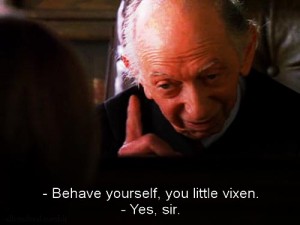
 As fate and my innamorata would have it, I watched (within the space of a few days) two movies based on old Ira Levin novels: The Stepford Wives and Rosemary’s Baby.
As fate and my innamorata would have it, I watched (within the space of a few days) two movies based on old Ira Levin novels: The Stepford Wives and Rosemary’s Baby.
It seems crazy to give a spoiler alert about movies a couple generations old, so I’ll cut to the chase. Both stories end with the main character, a woman, happily at home in the heart of her family, and in an extended and supportive community.
In other words, these are nightmares.
Do the stories need to be told? In Rosemary’s Baby, Rosemary (played by an infantile Mia Farrow) and her husband Guy (a snakelike and disturbing turn by John Cassavetes) move into a rent-controlled apartment in New York. The delightfully wacky couple next door (Ruth Gordon and Sidney Blackmer) are the leaders of a Satanic cult who are hoping to bring about the birth of the Antichrist. They recruit Guy to their cause fairly easily: he’s a struggling actor and they use their magical powers to destroy someone standing in his way. Then, with Guy’s help, they drug Rosemary and the devil shows up to impregnate her, in what is the dumbest moment in the movie. (Certain things are more disturbing if they’re implied.) The second half of the movie follows Rosemary as she catches on, which happens very… slow…ly. So… s.l.o.w.l.y… I found it difficult to like the character or sympathize with her. The Satanists provided some nihilistic entertainment whenever they showed up, though. In the end, Rosemary is confronted with her child and accepts him, to the approval of all. She is, after all, his mother.
Polanski directed the movie–a man who knows something about creepiness from the inside out. Rosemary’s dreams were nicely unsettling collections of images. And when Rosemary picks up the issue of Time magazine with the (in)famous cover-story IS GOD DEAD? it was a very sneaky moment of ironic horror. She doesn’t know it, but there’s no question for her. That is hell, nor is she out of it.
 The camera is on Farrow most of the time. That’s a weakness in the film, as her character was very passive and Farrow–um–played the character much as written. But there’s a lot of creepy interest generated by the supporting players: Ruth Gordon (who picked up her sole Oscar as a supporting actress for this role), Ralph Bellamy (as the warmly officious Dr. Sapirstein who looks like that fellow in the movies–you know–Ralph Bellamy), and John Cassavetes (as the wife-pimping Satanist and sometime television actor). Almost all the Satanists were familiar faces, in a third-tier sort of way. (One of them was Phil Leeds, for instance, whose last semi-regular role was Judge Happy Boyle on Ally McBeal.) When they shout, “Hail, Satan!” or crap like that, it felt like I was watching a sitcom broadcast from Hell. That is the best and the worst thing I can say about this strange and disturbing movie.
The camera is on Farrow most of the time. That’s a weakness in the film, as her character was very passive and Farrow–um–played the character much as written. But there’s a lot of creepy interest generated by the supporting players: Ruth Gordon (who picked up her sole Oscar as a supporting actress for this role), Ralph Bellamy (as the warmly officious Dr. Sapirstein who looks like that fellow in the movies–you know–Ralph Bellamy), and John Cassavetes (as the wife-pimping Satanist and sometime television actor). Almost all the Satanists were familiar faces, in a third-tier sort of way. (One of them was Phil Leeds, for instance, whose last semi-regular role was Judge Happy Boyle on Ally McBeal.) When they shout, “Hail, Satan!” or crap like that, it felt like I was watching a sitcom broadcast from Hell. That is the best and the worst thing I can say about this strange and disturbing movie.
In The Stepford Wives, Joanna Eberhart (Katharine Ross) and her husband Walter move to the village of Stepford Connecticut. The village has a bunch of mindlessly happy homemakers and a crew of smug upper-class husbands who all belong to the Stepford Men’s Association. Joanna, a woman with arty ambitions (she wants to be a photographer) feels stifled.
Joanna falls in with kindred spirit and patented insto-friend Bobbie Markowe (played by a rather glorious Paula Prentiss). Together they try to bring Stepford some consciousness-raising. (Remember that, kids? No? Oh, well–you can always google it.) But they get no takers: all the Stepford wives are contentedly empty and willing to spend their lives in the service of their husbands almost as if they’re robots or something.
When Bobbie is robotified, Joanna knows she’s next and she tries to get away. But her kids have been taken away. She’s told that they are being kept in the headquarters of the Men’s Association and she goes there to get them. But it’s a trick. The head of the Men’s Association patiently explains to Joanna that he knew she would come there, because she’s a good mother. Then she is killed by her robot double, and good old Walter gets the robot wife he thinks he deserves and (let’s face it) probably does.
The director, Bryan Forbes, is by no means as skilled an operator as Roman Polanski. (I’m not endorsing the character of the famed director and rapist. I’m just saying he knows how to make a creepfest.) But Forbes does the job pretty well, and the idyllic stills of a happy and inhuman family running behind the credits were a nicely ironic touch.
Plus, the robot-Joanna was different from the real Joanna in two significant and disturbing ways. Its eyes were darkly vacant orbs, and it had cartoonishly large breasts (as opposed to Ms. Ross’ sleeker frame). You can imagine her husband Walter putting in his order for this thing, looking at the body of Katharine Ross (de gustibus, and all that, but she was and is an undeniably beautiful woman) and saying, “But I want it to have bigger tits. LIKE THIS.” It was funny and sad, unexpected and yet, in retrospect, inevitable.
There are some good performances by the supporting cast here, too, especially Paula Prentiss (before and after her robotification), and some of the men who show understandable grief and guilt even as they cooperate in the murder of their wives.
In a way, both these stories are the same story. These women are destroyed by their identities as mothers. Rosemary, a passive cipher of a character, can’t imagine herself as anything but the mother of her baby. She can reject her husband, when she finds out what he’s done, but she can’t reject the bouncing baby Antichrist. Joanna is much more decisive and prepared to act, in defense of herself and others. But the need to recover her children lures her into the final trap, where she surrenders almost as willingly as Rosemary.
In the 37 years since The Stepford Wives, though, society has changed and men no longer consider women as mere commodities for their own gratification.
Ha ha. I kid. But I think this nihilistic view of motherhood is both the biggest strength and weakness of the films. We can’t afford to assent to this dark hellish view of something essential to the survival of the species. But we can’t deny that there is a threat to the individual in something so transformative, so enwebbed in obligations to others.

